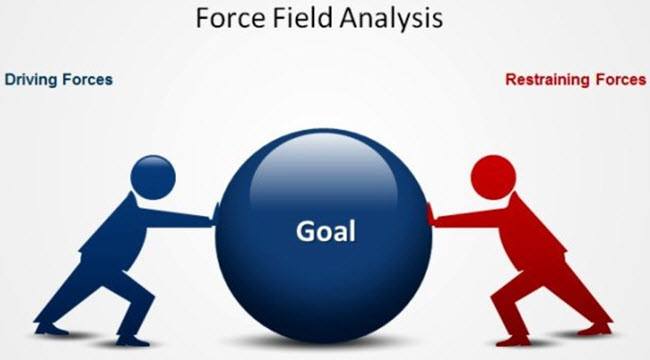Force field analysis is a specialized technique of weighing up the advantages and disadvantages of a project, to help decide whether any proposed change is worth implementing. The method was first developed by psychologist Kurt Lewin, a pioneer in the field of social psychology. Lewin’s intent was to create a tool that would allow a group to diagnose a particular situation by examining all of the forces for and against a plan to decide whether or not the plan is worth implementing. Forces that push a decision in a particular direction are called driving forces, while restraining forces are defined as those that hinder the decision making process.
Force field analysis allows you to examine all the various forces in play for and against a decision that needs to be made. Somewhat different from the process of listing pros and cons, force field analysis allows you to develop decision making strategies in terms of strengthening the forces in support of decision and reducing the impact of any opposition.
Advantages of Force Field Analysis
- One of the key advantages of a force field analysis is that it provides a visual summary of all the various factors supporting and opposing a particular idea, with all the data that has been collected regarding a potential decision consolidated into a single graph.
- Force field analysis help us to identify obstacles that lie ahead so that we can make a plan to strengthen the forces supporting the decision and take actions to reduce or avoid the forces preventing it.
- A force field analysis diagram can be used as a visual aid and it will help simplify communication among the staff and to break down communication barriers.
- A force field analysis diagram can assist the group to develop a common understanding of the subject and all the group members will have a clear concept of the opinions and the options related to the situation.
- Force field analysis also expands the evaluation beyond the data itself to look at qualitative factors that may have an impact on the success of failure of the decision being analysed.
Disadvantages of Force Field Analysis
- Force field analysis requires the full participation of everyone involved to provide the accurate information needed for an effective analysis. This can be a disadvantage when full participation isn’t possible, resulting in a report that doesn’t provide a realistic picture of the supporting and opposing forces.
- Another potential problem is the possibility that the analysis won’t result in a consensus among the group. In fact, a force field analysis may cause a division in the group between those who support the change and those who are against the modification
One of the key things to keep in mind when using force field analysis is that the analysis developed is entirely dependent upon the skill level and knowledge of the group working on the analysis. In most cases, force field analysis is based on assumptions, not facts; even if the assumptions are based on accumulated data, the interpretation of the data shouldn’t be interpreted as being objective within the overall process of evaluating the driving and restraining forces.
Conclusion on Force Field Analysis Advantages and Disadvantages
In conclusion, force field analysis, in addition to other techniques, can be used to help decision makers in their pursuit of controlled and effective change management. Successful implementation of change will improve an organisations success and survival.






